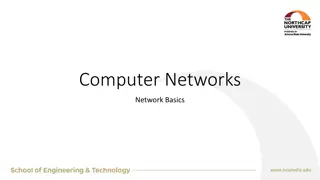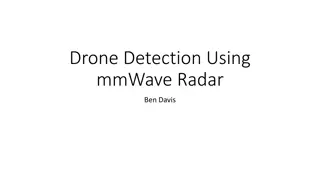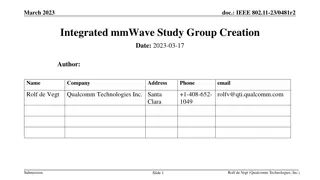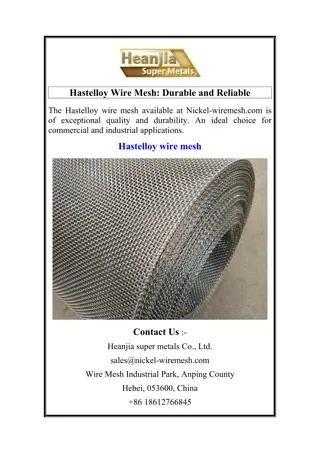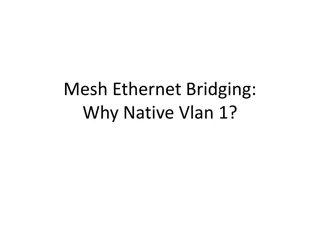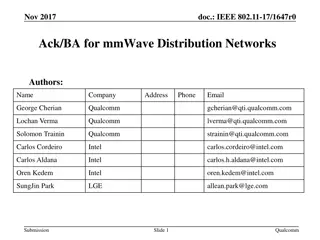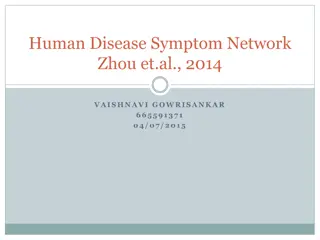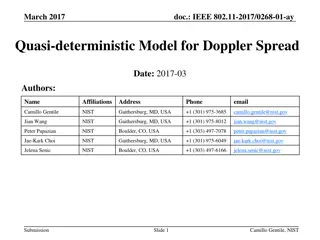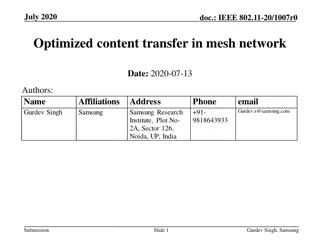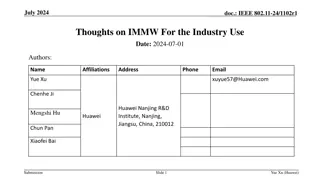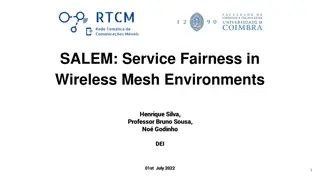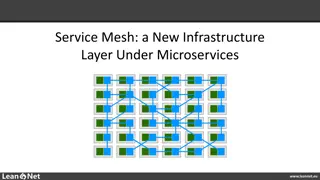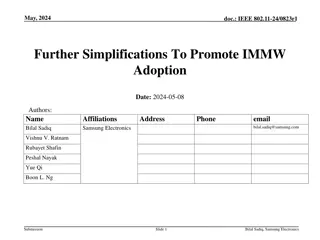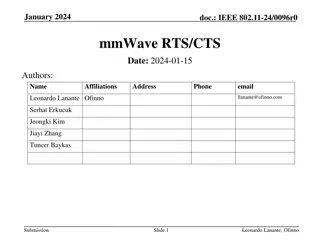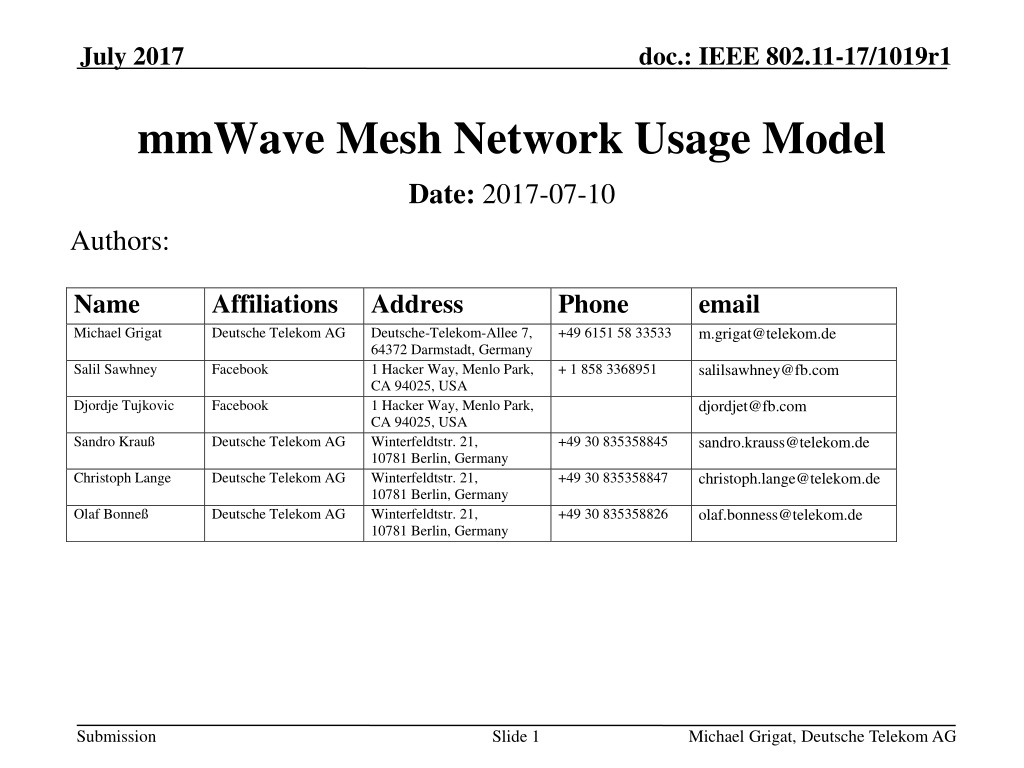
mmWave Mesh Network Usage Model in IEEE 802.11-17 Document
This document outlines a proposed use case for a mmWave mesh network within the IEEE 802.11-17 framework, focusing on applications such as broadband residential access, Wi-Fi AP, small cell backhaul, and more. It discusses the benefits, motivation, and potential of utilizing mmWave technology for high-performance, cost-efficient wireless networking solutions.
Download Presentation

Please find below an Image/Link to download the presentation.
The content on the website is provided AS IS for your information and personal use only. It may not be sold, licensed, or shared on other websites without obtaining consent from the author. If you encounter any issues during the download, it is possible that the publisher has removed the file from their server.
You are allowed to download the files provided on this website for personal or commercial use, subject to the condition that they are used lawfully. All files are the property of their respective owners.
The content on the website is provided AS IS for your information and personal use only. It may not be sold, licensed, or shared on other websites without obtaining consent from the author.
E N D
Presentation Transcript
July 2017 doc.: IEEE 802.11-17/1019r1 mmWave Mesh Network Usage Model Date: 2017-07-10 Authors: Name Michael Grigat Affiliations Deutsche Telekom AG Address Deutsche-Telekom-Allee 7, 64372 Darmstadt, Germany 1 Hacker Way, Menlo Park, CA 94025, USA 1 Hacker Way, Menlo Park, CA 94025, USA Winterfeldtstr. 21, 10781 Berlin, Germany Winterfeldtstr. 21, 10781 Berlin, Germany Winterfeldtstr. 21, 10781 Berlin, Germany Phone +49 6151 58 33533 email m.grigat@telekom.de salilsawhney@fb.com Salil Sawhney Facebook + 1 858 3368951 djordjet@fb.com Djordje Tujkovic Facebook sandro.krauss@telekom.de Sandro Krau Deutsche Telekom AG +49 30 835358845 christoph.lange@telekom.de Christoph Lange Deutsche Telekom AG +49 30 835358847 olaf.bonness@telekom.de Olaf Bonne Deutsche Telekom AG +49 30 835358826 Submission Slide 1 Michael Grigat, Deutsche Telekom AG
July 2017 doc.: IEEE 802.11-17/1019r1 Abstract This presentation describes a use case for a mmWave mesh network that can be applied in different deployment scenarios: Broadband residential access (WTTB, WTTH) Wi-Fi AP & Small cell backhaul It is proposed to add a new usage model on mmWave Mesh network to the 802.11ay use case document. WTTH: Wireless Ro The Home WTTB: Wireless To The Building Submission Slide 2 Michael Grigat, Deutsche Telekom AG
July 2017 doc.: IEEE 802.11-17/1019r1 Introduction mmWave Mesh networks exhibit a promising cost-efficient high- performance alternative and/or complement to conventional fixed access networks. In comparison to usage model 8, focus is more on Mesh wireless backhaul and Fixed wireless access, beside Small cell & WiFi AP BH. Adaptive PtMP approach and Mesh functionality required, as changing LOS conditions for single links can cause problems. Mesh network architecture deployment is expected to lead to significant increase in operational efficiency and reliability. Existing standards cover aspects of mmWave technology [1] and meshed wireless networks [2]. In order to cover mmWave Mesh networks, the 11ay use case document [3] has to be extended by a respective usage model. Submission Slide 3 Michael Grigat, Deutsche Telekom AG
July 2017 Service Provider Motivation for mmWave Mesh Networks Conventional fiber access networks provide high performance and reliability but are very expensive and time consuming in their deployment. doc.: IEEE 802.11-17/1019r1 mmWave Mesh networks have the potential to provide several advantages from provider perspective: Fast time-to-market through rollout speedup Aiming at high coverage and low upfront cost Synergy with other radio rollouts (e.g. SC, WLAN) Little to no installation at customer site Less coordination with various building owners Besides that SPs are targeting to different aspects that can be also delivered by a mmWave Mesh Network: Adaptive topologies (mesh, tree, point-to-point etc.) Resilience and redundancy (e.g. for avoiding LoS link failures / outages) Steering of traffic and bandwidth/link utilization It is assumed that a mmWave Mesh Network is able to cover typical customer bases of a few street cabinets (in terms of range, number of subscribers, and bandwidth). Submission Slide 4 Michael Grigat, Deutsche Telekom AG
July 2017 doc.: IEEE 802.11-17/1019r1 mmWave Mesh Network Area View Small cell Provider Network Wi-Fi AP Fiber PoP (cabinet) Fiber PoP (to Provider Network) fiber Focus on use case specific Mesh WBH requirements mmWave AP mmWave link Mesh Wireless Backhaul LOS 60 GHz narrow beam system Own management and control per mmWave mesh access area Route control protocol supports re- routing over radio links Auto-alignment installations via adaptive beamforming Redundancy of active equipment at first pole next to fiber PoP or via connections to 2 or more fiber PoPs Radio link degradation and outage recognition w/ failure localisation WTTH Use case a) WTTH Small cell Use case c) WiFi AP / SC Use case b) WTTB WTTH Wi-Fi- AP RGW Alternative: Wireless inhouse Submission Slide 5 Michael Grigat, Deutsche Telekom AG
July 2017 doc.: IEEE 802.11-17/1019r1 mmWave Mesh Network Use Case Matrix a) Wireless To The Home (WTTH) A fixed-wireless access (FWA) scenario for residential access Each flat is equipped with a receive / transmit window antenna (sector) mmWave Wireless Backhaul c) Wi-Fi AP & Small Cell a) WTTH b) WTTB Window antenna1) b) Wireless To The Building (WTTB) A FWA scenario for residential access Each building is equipped with a receive / transmit outdoor-wall antenna (sector) The in-building distribution is achieved by an in-building wireless or fixed network Inhouse Wireless AP + Repeater2) Street pole X X X Mesh Wireless BH House wall X X c) WiFi AP / Small Cell Backhaul A nomadic and mobile usage scenario for Wi-Fi or 5G services Each user equipment / device represents an end node X Rooftop 1) No additional building outside-wall antenna for WTTH 2) E.g. wireless AP in the floor plus repeater at home NT Submission Slide 6 Michael Grigat, Deutsche Telekom AG
July 2017 Distance Distribution Operator Example for mmWave Mesh Networks doc.: IEEE 802.11-17/1019r1 Dense urban area Purpose and methodology Provide broadband coverage for dense urban, urban, rural service areas in a timely and cost efficient way Exemplary assessment: Dense urban area 100m Result: Distance classes Street Furniture to Building Standard distance < 15 m Extended distance < 100 m Street Furniture to Street Furniture Standard distance < 60 m Extended distance 1 < 120 m Extended distance 2 < 300 m Basis: BEHRENS, C.; LANGE, C.; GLADISCH, A.: Challenges for Optical Wireless: An Operator s Perspective. In: Optical Fiber Communications Conference (OFC). Workshop: Optical Wireless Can it Become a Gigabit Wireless Alternative? Capabilities, Opportunities, Challenges and Threats, Los Angeles (CA, USA), March 19 23, 2017 Submission Slide 7 Michael Grigat, Deutsche Telekom AG
July 2017 New Usage Model: mmWave Mesh Network doc.: IEEE 802.11-17/1019r1 Use cases: Fiber PoP a) WTTH fiber Provider Network b) WTTB Fiber PoP mmWave Mesh Network c) Wi-Fi AP/ Small Cell fiber Fiber PoP Legend: mmWave sector mmWave Distribution Node, one or more collocated mmWave sectors optical fiber termination node Submission Slide 8 Michael Grigat, Deutsche Telekom AG
July 2017 doc.: IEEE 802.11-17/1019r1 New Usage Model: mmWave Mesh Network Pre-Conditions: A number of 11ay DNs forms a wireless outdoor mmWave Mesh network over multiple hops in order to reach coverage. In addition to the Mesh backhaul, also a point-to-multipoint mmWave access network is build to serve homes, buildings, WiFi-AP and small cells. Environment: Devices operate in outdoor environment with LOS under most conditions. For multiple hop wireless backhauling devices, distance per hop between the paired DNs is < 300 m (street-poles), < 1000 m (rooftop), and the distance between DNs and WTTH/B Home/Building APs is < 100 m. Application WTTH Access: The mmWave Mesh backhaul will be used for backhauling of WTTH DNs, which are placed at street poles (e.g. lamppost). The WTTH DNs serve the individual homes/ flats via a window AP at client side instead of deploying expensive fiber networks in the building branch and inhouse. The WTTH radio links work on the same or optional on different mmWave frequency than the mmWave Mesh backhaul links. Interference Conditions: Interference from environmental conditions or other mmWave operations in the same area. Obstructions of the LOS and beam un-alignments. Application WTTB Access: The mmWave Mesh backhaul will be used for backhauling of WTTB DNs, which are placed at street poles (e.g. lamppost) or at walls or rooftops. The WTTB links work on the same mmWave frequency as the mmWave Mesh backhaul links. If street poles are used, the WTTB DNs serve the buildings via an outdoor-wall AP. In case of Wall-to-Wall or Roof-to-Roof backhaul, it serves at the same time as mmWave building access network without usage of additional street poles. The WTTB scenario requires an additional wireless or fixed inhouse network to serve the individual flats. Use Case: 1. The mmWave WTTH/B DNs, which offer FTTH- like broadband access for residential customers as well as Small cells and WiFi-APs (e.g. 802.11ac), which offer mobile and nomadic services, are connected to a mmWave mesh backhaul network. 2. The 11ay mmWave Mesh backhaul network connects by optical fiber to 1 or more fiber-PoPs towards the Telco / Service Provider network. 3. Redundancy of active radio equipment via Mesh topology and redundant central WBH DN at first pole near the fiber-PoP (no Single-Point-of-Failure) 4. The Internet connectivity QoS/QoE and latency requirements are met with the user s applications. Application WiFi-AP & Small cell Backhaul: The mmWave Mesh backhaul will be used for backhauling of Small Cells and Wi-Fi APs, which are e.g. placed at street poles. Traffic of mobile and nomadic services will be aggregated and carried towards the mobile core. The sub-6 GHz NLOS operation of the Small Cells and Wi-Fi APs imposes less challenges compared to WTTH/B to reach inhouse (mobile) users, however does not reach the capacity level of the WTTH/B solutions. Submission Slide 9 Michael Grigat, Deutsche Telekom AG
July 2017 New Usage Model: Operational Requirements doc.: IEEE 802.11-17/1019r1 The mmWave Mesh network will be formed by a number of 11ay outdoor DNs, which are used for backhauling of the proposed applications. In addition to the Mesh backhaul, also a PtMP mmWave access network is build to serve the homes/buildings. The mmWave Mesh network need to support a transmission over multiple hops in order to reach area coverage. Distance per hop between paired DNs is up to 300 m and distance between DN sites and WTTH/B Home/Building APs is up to 100 m. The number of hops in a daisy-chain is limited by area topology constraints, resulting in < 5 hops typically. The system have the capability to support up to 15 hops to meet region specific requirements. The mmWave DNs have to operate in outdoor environments with LOS under most conditions, taking into account potential constraints. Interference from environmental conditions or other mmWave operations in the same area Obstructions of the LOS and beam un-alignments. The network has to support different DN placement options such as street poles (e.g. lamppost), house-walls and rooftops. Redundancy will be achieved via the Mesh topology Single-Points-of-Failure have to be avoided, either by redundant active equipment at the first pole next to the fiber-PoP or alternative via connection of the Mesh network to 2 or more fiber-PoPs The 11ay Mesh network connects by optical fiber towards the Telco / Service Provider network. Requirements (operator example) # of hops (outdoor)* mmWave Mesh Wireless Backhaul < 5 (typically) < 15 (system capability) < 300 m (street-poles) < 1000 m (rooftops) < 80 / km Mesh, PtMP, Daisy chain > 4 Gbps / DN site mmWave Home/ Building Access 1 LOS distance / link < 100 m # of DN Topology support Data Rate (DL sustainable) Antenna features Latency (RTT) (e-t-e mmWave) QoS, Security, Sync. Availability of sust. data rate home/building density PtP, PtMP > 1 Gbps / Home AP > 2 Gbps / Building AP Beam-forming/tracking; Auto-alignment < 15 ms (WTTH/B, WiFi AP BH) < 5 ms (5G Small cell BH) QoS/QoE, Security C/I and Sync. support No guarantees in an unlicensed environment. > 99% should be aimed (e-t-e mmWave) # of hops depends on latency requirements Submission Slide 10 Michael Grigat, Deutsche Telekom AG
July 2017 doc.: IEEE 802.11-17/1019r1 Proposed changes to 11ay use case document [3] The authors of this presentation request the TGay to agree on the sketched use case mmWave mesh network as a valid use case for 802.11ay that should be added to the 11ay use cases. The authors of this presentation propose to add a corresponding use case description (slides 8-10) to the 802.11ay use case document IEEE 802.11-15/0625r3 IEEE 802.11 TGay Use Cases [3]. Submission Slide 11 Michael Grigat, Deutsche Telekom AG
July 2017 doc.: IEEE 802.11-17/1019r1 Summary Three use cases of mmWave mesh networks have been presented: mmWave-based broadband home access (WTTH) mmWave-based broadband building access (WTTB) Wi-Fi AP & Small Cell backhaul A description of this use case should be added to the 802.11ay use case document IEEE 802.11-15/0625r3 IEEE 802.11 TGay Use Cases [3]. 802.11ay related requirements for the mmWave mesh network architecture will be derived for the above mentioned use case and presented to TGay. Submission Slide 12 Michael Grigat, Deutsche Telekom AG
July 2017 doc.: IEEE 802.11-17/1019r1 Straw Poll #1 Do you support the proposal to add the usage model mmWave mesh network described in this document (slides 8-10) to a revised version of document IEEE 802.11-15/0625r3 IEEE 802.11 TGay Use Cases ? Yes: No: Abstain: Submission Slide 13 Michael Grigat, Deutsche Telekom AG
July 2017 doc.: IEEE 802.11-17/1019r1 Motion #1 Do you agree on the proposal to add the usage model mmWave mesh network described in this document (slides 8- 10) to a revised version of document IEEE 802.11-15/0625r3 IEEE 802.11 TGay Use Cases ? Yes: No: Abstain: Submission Slide 14 Michael Grigat, Deutsche Telekom AG
July 2017 doc.: IEEE 802.11-17/1019r1 Straw Poll #2 Do you support the proposal to add the usage model mmWave mesh network (slides 8-10) as a separate usage model to document IEEE 802.11-15/0625r3 IEEE 802.11 TGay Use Cases ? Yes: No: Abstain: Submission Slide 15 Michael Grigat, Deutsche Telekom AG
July 2017 doc.: IEEE 802.11-17/1019r1 Motion #2 Do you agree on the proposal to add the usage model mmWave mesh network (slides 8-10) as a separate usage model to document IEEE 802.11-15/0625r3 IEEE 802.11 TGay Use Cases ? Yes: No: Abstain: Submission Slide 16 Michael Grigat, Deutsche Telekom AG
July 2017 doc.: IEEE 802.11-17/1019r1 References [1] IEEE Standards Association: IEEE P802.11ad , Standard for Information Technology Telecommunications and Information Exchange Between Systems Local and Metropolitan Area 12 Networks Specific Requirements Part 11: Wireless LAN Medium Access Control (MAC) and Physical Layer (PHY) Specifications Amendment 3: Enhancements for Very High Throughput in the 60 GHz Band , 2012. [2] IEEE Standards Association: IEEE Std 802.11s , IEEE Standard for Information Technology Telecommunications and information exchange between systems Local and metropolitan area networks Specific requirements Part 11: Wireless LAN Medium Access Control (MAC) and Physical Layer (PHY) specifications Amendment 10: Mesh Networking , 2011. [3] IEEE 802.11-15/0625r3 IEEE 802.11 TGay Use Cases [4] Challenges for Optical Wireless: An Operator s Perspective. Behrens, C.; Lange, C.; Gladisch, A.: Optical Fiber Communications Conference (OFC). Workshop: Optical Wireless Can it Become a Gigabit Wireless Alternative? Capabilities, Opportunities, Challenges and Threats, Los Angeles (CA, USA), March 19 23, 2017 Submission Slide 17 Michael Grigat, Deutsche Telekom AG
July 2017 doc.: IEEE 802.11-17/1019r1 Abbreviations AP Access Point PoP Point of Presence BH Backhaul PtMP Point to Multipoint C/I Confidentiality/Integrity QoE Quality of Experience DL Downlink QoS Quality of Service DN mmWave Distribution Node RGW Residential Gateway EIRP Equivalent Isotropically Radiated Power RTT Round Trip Time EMC Electromagnetic Compatibility SC Small Cell FTTH Fiber to the Home WBH Wireless Backhaul FWA Fixed-Wireless Access WLAN Wireless Local Area Network LOS Line of Sight WTTB Wireless to the Building NLOS Non-Light of Sight WTTH Wireless to the Home NT Network Termination Submission Slide 18 Michael Grigat, Deutsche Telekom AG
July 2017 doc.: IEEE 802.11-17/1019r1 Appendix Use case details WTTH Access WTTB Access Wi-Fi AP & Small Cell BH Submission Slide 19 Michael Grigat, Deutsche Telekom AG
July 2017 doc.: IEEE 802.11-17/1019r1 Use Case: a) WTTH Access Pre-Conditions: A number of 11ay DNs forms a wireless outdoor mmWave Mesh backhaul network. The transmissions in the mmWave Mesh network can be over multiple hops. In addition to the Mesh backhaul, also a point-to-multipoint mmWave home access network is build. Environment: Devices operate in outdoor environment with LOS under most conditions. For multiple hop wireless backhauling devices, distance per hop between the paired DNs is < 300 m and distance between DNs and WTTH Home APs is < 100 m. Application: The mmWave Mesh backhaul will be used for backhauling of WTTH DNs, which are placed at street poles (e.g. lamppost). The WTTH DNs serve the individual homes/ flats via a window AP at client side instead of deploying expensive fiber networks in the building branch and inhouse. The WTTH radio links may work on same or optional on different mmWave frequency than the mmWave Mesh backhaul links. Interference Conditions: - Potential interference from environmental factors and obstruction of the LOS, beam un-alignment. - Street canyon effect Requirements (operator example) # of hops (outdoor) LOS distance / link # of DN Topology support Data Rate (DL sust.) EIRP / EMC Antenna gain mmWave mmWave Home Access 1 < 100 m home density PtP, PtMP > 1 Gbps / Home AP Use Case: 1. The mmWave WTTH DNs, which serve FTTH- like residential broadband access for individual homes, are connected to a mmWave mesh backhaul network. 2. The 11ay mmWave Mesh backhaul network connects by optical fiber to 1 or more fiber-PoPs towards the Telco / Service Provider network. 3. Redundancy of active radio equipment via Mesh topology and redundant central WBH DN at first pole near the fiber-PoP (no Single Point of Failure) 4. The Internet connectivity QoS/QoE and latency requirements are met with the user s applications. Mesh Wireless Backhaul < 5 < 300 m < 80 / km Mesh, PtMP, Daisy chain > 4 Gbps / DN site < 40 dBm / Beam (FCC) Today s regulation for PtP links (e.g. >35 dBi Germany) Subject to change for PtMP (e.g. >20 - 22 dBi) Beam-forming/tracking; Auto-alignment < 15 ms (e-t-e mmWave) QoS/QoE, Security C/I and Sync. support No guarantees in an unlicensed environment. > 99% should be aimed (e-t-e mmWave) Antenna features Latency (RTT) QoS, Security, Sync. Availability of sust. data rate Submission Slide 20 Michael Grigat, Deutsche Telekom AG
July 2017 doc.: IEEE 802.11-17/1019r1 Use Case: b) WTTB Access Pre-Conditions: A number of DNs forms a wireless outdoor mmWave Mesh backhaul and point-to-multipoint mmWave building access network. The transmissions in the mmWave Mesh network can be over multiple hops. Application: The mmWave Mesh backhaul will be used for backhauling of WTTB DNs, which are placed at street poles (e.g. lamppost) or at walls or at rooftops. The WTTB DNs work on the same mmWave frequency as the mmWave Mesh backhaul DNs. If street poles are used, the WTTB DNs serve the buildings via an outdoor-wall AP. In case of Wall-to-Wall or Roof-to-Roof mmWave Mesh backhaul, it serves at the same time as mmWave building access network without usage of additional street poles. The WTTB use case requires an additional wireless or fixed inhouse network, in contrast to WTTH, to serve the individual flats. Requirements (operator example) Street Pole- to-Pole Wall # of hops (outdoor) < 5 LOS distance / link < 300 m < 300m # of DN < 80 / km Topology support Mesh, PtMP, Daisy chain Data Rate (DL sust.) > 4 Gbps / DN site EIRP / EMC Antenna gain Today s regulation for PtP links (e.g. >35 dBi Germany) Subject to change for PtMP (e.g. >20 - 22 dBi) Antenna features Beam-forming/tracking; Auto-alignment Latency (RTT) < 15 ms (e-t-e mmWave) QoS, Security, Sync. QoS/QoE, Security C/I and Sync. support Availability of sust. data rate > 99% should be aimed (e-t-e mmWave) Environment: Devices operate in outdoor environment with LOS under most conditions. For multiple hop wireless backhauling devices , distance per hop between the paired DNs is < 300 m (pole/wall) resp. < 1000 m (rooftop) and distance between DNs at pole and WTTB building APs is < 100 m. Interference Conditions: - Potential interference from environmental factors and obstruction of the LOS, beam un-alignment. - Street canyon effect mmWave Mesh Wireless Backhaul mmWave Building Access Additional in case of WBH at street pole 1 < 100 m building density PtP, PtMP >2 Gbps/ Building AP Use Case: 1. The 11ay mmWave WTTB DNs, which serve FTTH-like residential broadband access for buildings, are connected to a mmWave Mesh backhaul network. 2. The 11ay mmWave Mesh backhaul network connects by optical fiber to 1 or more fiber-PoPs towards the Telco / Service Provider network. 3. Redundancy of active radio equipment via Mesh topology and redundant central WBH DN at first pole near the fiber-PoP (no Single Point of Failure) 4. The Internet connectivity QoS/QoE and latency requirements are met with the user s applications. Wall-to- Roof-to- Roof < 5 < 1000 m < 5 < 40 dBm / Beam (FCC) No guarantees in an unlicensed environment. Submission Slide 21 Michael Grigat, Deutsche Telekom AG
July 2017 doc.: IEEE 802.11-17/1019r1 Use Case: c) WiFi AP & Small Cell BH Pre-Conditions: A number of 11ay DNs forms a wireless outdoor mmWave Mesh backhaul network. The transmissions in the mmWave Mesh network can be over multiple hops. Environment: Devices operate in outdoor environment with LOS under most conditions. For multiple hop wireless backhauling devices , distance per hop between the paired DNs is < 300 m. Application: The mmWave Mesh backhaul will be used for backhauling of Small Cells and Wi-Fi APs, which are e.g. placed at street poles. Traffic of mobile and nomadic services will be aggregated and carried towards the mobile core. The sub-6 GHz NLOS operation of the Small Cells and Wi-Fi APs imposes less challenges compared to WTTH/B to reach inhouse (mobile) users, however does not reach the capacity targets of the WTTH/B solutions. Interference Conditions: - Potential interference from environmental factors and obstruction of the LOS, beam un-alignment. - Street canyon effect Use Case: 1. 5G Small cells (mobile radio) and WiFi APs (e.g. 802.11ac) are backhauled via mmWave Mesh network. 2. The 5G Small cells and Wi-Fi APs offer mobile and nomadic services to the customers. 3. The 11ay mmWave Mesh backhaul network connects by optical fiber to 1 or more fiber-PoPs towards the Telco / Service Provider network. 4. Redundancy of active radio equipment via Mesh topology and redundant central WBH DN at first pole near the fiber-PoP (no Single Point of Failure) 5. The Internet connectivity QoS/QoE and latency requirements are met with the user s applications. Requirements (operator example) # of hops (outdoor) LOS distance / link # of DN Topology support Data Rate (DL sust.) EIRP / EMC Antenna gain mmWave Mesh Wireless Backhaul for 5G Small cells < 5 < 300 m < 80 / km Mesh, PtMP, Daisy chain > 1 Gbps / AP < 40 dBm / Beam (FCC) Today s regulation for PtP links (e.g. >35 dBi Germany) Subject to change for PtMP (e.g. >20 - 22 dBi) Beam-forming/tracking; Auto-alignment < 5 ms (e-t-e mmWave) QoS/QoE, Security C/I and Sync. support No guarantees in an unlicensed environment. > 99% should be aimed (e-t-e mmWave) for Wi-Fi APs < 5 < 300 m > 300 Mbps / AP Antenna features Latency (RTT) < 15 ms (e-t-e mmWave) Best effort QoS, Security, Sync. Availability of sust. data rate Submission Slide 22 Michael Grigat, Deutsche Telekom AG



